In Ancient Greece, public speaking was the main channel for political debate and decision-making, legal decision-making, and even philosophical discussion.
As it became more and more important to society, so did rhetoric, which is the art of persuasive speaking and writing. Ancient philosophers like Plato, Aristotle, and Cicero studied and practiced rhetoric… essentially boiling it down to a do-it-yourself guide.
That guide has been lost (ok, just forgotten). Until now.
Table of contents
What Does This Have to Do With CRO?
All of this sounds a lot like copywriting, don’t you think?
While the ancient Greeks may not have crafted rhetorical theories with copywriters in mind, they’re incredibly applicable.
The tactics have changed. The language has changed. The audience has changed. The society has changed. Still, these underlying persuasive theories remain relevant to modern copywriters.
Once you understand the theory, you can begin to apply it to PPC ads, landing pages, etc.
An Introduction to Aristotle’s 3 Appeals
Aristotle was a Greek philosopher and scientist. When he was 18-years-old, he joined Plato’s Academy and remained there for nearly 20 years.
If you’ve ever attended a university English class, you’re already familiar with Aristotle’s three appeals: ethos, pathos, and logos. As it turns out, they aren’t just ancient terms reserved exclusively for academics.
1. Ethos
Ethos is an appeal to the authority or credibility of the presenter. It is how well the presenter convinces the audience that he or she is qualified to present (speak) on the particular subject.
Ethos can be done in a number of ways. A few examples…
- Holding a prestigious title (e.g. professor, PhD, CMO).
- Working for / with a well-recognized company in the industry (e.g. Optimizely, Inbound.org).
- Using industry terminology (e.g. CTR, lift, decision fatigue, UVP).
- Being introduced or vouched for by someone with more credibility (e.g. a warm email intro, social proof on a landing page).
The list goes on and on. Essentially, ethos is about demonstrating (a) your authority on the subject and (b) your morality.

Joel Klettke, Business Casual Copywriting:
“I do believe persuasive copy is about getting someone to take action, but I don’t believe in getting people to ‘fall for’ my copy. It might seem like I’m splitting hairs over semantics, but there’s an important difference in mentality between those who want people to ‘fall for’ their offer and those who want to be persuasive.
The best marketing – and the best copy – is not about duping the reader into believing something, but about amplifying their need, alleviating their fear and exciting them to action. So often we forget (or simply ignore) that a qualified lead arrives with an intention to make a decision.” (via Business Casual Copywriting)
For example, look at how Timothy Sykes demonstrates his authority on the subject of penny stock trading…

But don’t mistake him for a money-hungry Scrooge…

How to apply it…
- Inject personal stories and successes into your copy to show you have real world experience.
- Use testimonials and other forms of social proof to demonstrate authority.
- Offer a privacy policy, a satisfaction guarantee, free shipping, etc. to build goodwill.
- Borrow credibility from someone with more ethos than you (e.g. guest post, co-host a webinar, have them tweet about your product).
- Use industry terms, but avoid big words and complicated sentence structures. Write the way you would speak if you were delivering your copy orally.
2. Pathos
Pathos is an appeal to the audience’s emotions, and the terms sympathy, pathetic and empathy are derived from it. It can be in the form of metaphor, simile, a passionate delivery, or even a simple claim that a matter is unjust.
Pathos is rarely effective on its own. Normally, ethos and logos are required to support it, but that doesn’t make it any less powerful.
It’s especially impactful when you call upon and agree with an emotion the audience already feels. Fear, for example, can be very persuasive. So can hope, desire and imagination.
Earlier this year, I wrote an in-depth article on emotional persuasion, which is rooted in this appeal. If you have 8-10 minutes, I suggest reading it for more ideas and applications.
Consider this powerful ad, which is essentially just copy, from the Cancer Patients Aid Association…

Does it make you think? Does it make you feel? Likely, it’s evoking shock and sadness. If you’re a regular smoker, perhaps even fear.
At Call to Action Conference, Talia Wolf of GetUplift.co shared this case study…
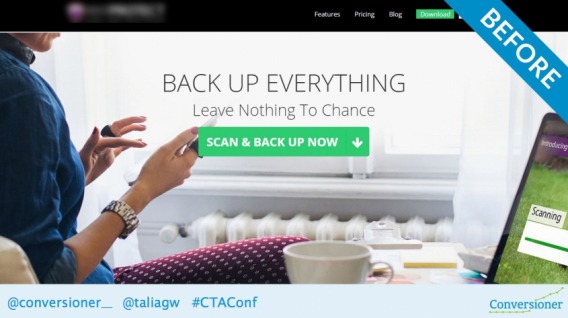
Pretty standard, right? The copy appeals mostly to our logical, rational brains. Why wouldn’t you back up your files? Anything could go wrong – it’s too risky.
For the treatment, Talia injected some emotion…
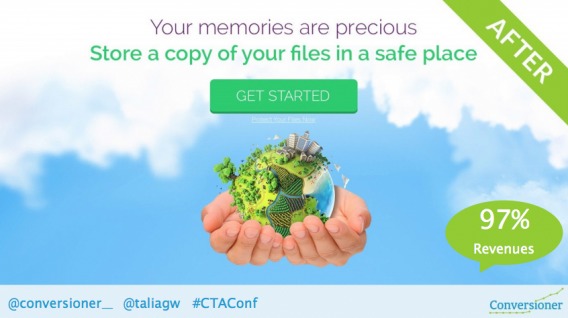
How to apply it…
- First, use stories and visuals to fully capture your visitors’ problem. Why are they here? What’s the problem they’re hoping you can solve for them? Before you persuade, you must remind them that they have this problem and need a solution for it.
- Use stories and visuals to capture the future (feat. your product or service). What will life be like after your product or service is purchased? What will life be like when the problem you just reminded them of disappears?
- Ask questions to push your visitors to think about their problem and the potential solution. I just asked you two questions in the last point. Did you answer them in your head? I’m willing to bet you did. Questions help your visitors make a personal connection with your copy.
- Combine ethos, pathos, and logos, but end on pathos. Add emotional triggers throughout your copy, but save the best for last. What will trigger such a strong emotional response that your visitors will have no choice but to respond to your call to action?
3. Logos
Logos is logical appeal or the simulation of it, and the term logic is derived from it. It is normally used to describe facts and figures that support the speaker’s claims or thesis.
Essentially, if you talk the talk, you better walk the walk. Everything you say must make logical sense and be backed up by cold, hard facts.
Logos can support ethos because if you have facts and data, you’re more likely to be considered an authority. However, it can also hinder ethos and activate pathos.
For example, without context, most data can be misleading and misinterpreted. It’s quite easy to immorally use logos (i.e. hinder ethos) to make your audience feel a certain way (i.e. activate pathos).
Consider how Democratic and Republican politicians can use the same data to persuade their separate audiences to feel very different ways.
For example, The Rich Jerk is seriously lacking logos in his call to actions…
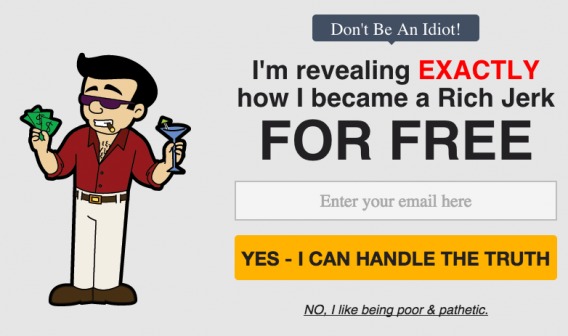
This is the perfect example of not “walking the walk”. On the other hand, we have sites like ROBIN…
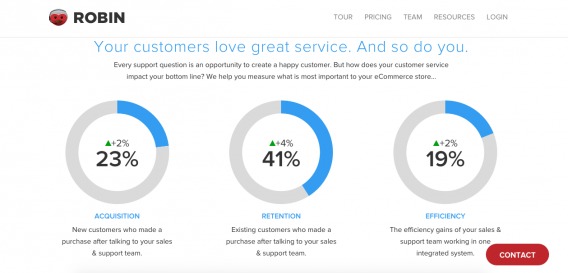
As an eCommerce customer service tool, it’s in ROBIN’s best interest to make the case for improved customer service. They back their claim and their value proposition (“Our software helps eCommerce stores turn their customer service into a money-making operation.”) with cold, hard facts.
This, of course, also supports ethos. The ROBIN team proves they know the customer service space… its strengths, its weaknesses and its opportunities.
How to apply it…
- Support the problem you’re solving with factual proof. Let’s say you’re a mattress company that wants to help with sleepless nights. How many Americans don’t get a full night of sleep? How many report waking up in the night or bad backs the next morning or constantly moving husbands who can’t get comfortable?
- Support your solution with factual proof. Why does it work? What makes it more unique than the next mattress? Who has it worked for? What were their results? Where are they now?
- Be clear because clarity converts. Don’t use hyperbole. No one believes signing up for your mailing list will change their life or make them rich. Also, don’t be vague. Be specific about the proof, about the numbers, about the facts. Don’t leave any room for doubt.
An Introduction to the 5 Canons of Rhetoric
Once an appeal is selected, you must begin crafting your message using the five canons of rhetoric, which were introduced by a philosopher named Cicero. The five canons are: invention, arrangement, style, memory, and delivery.
1. Invention
Invention is the method used for the discovery of arguments in Western rhetoric and comes from the Latin word, meaning “invention” or “discovery”. Invention is the central, indispensable canon of rhetoric, and traditionally means a systematic search for arguments.
The first and most important step is to find the best way to persuade your particular audience in this particular situation. There are four elements to this…
- Target. Who are you trying to persuade?
- Information. What information do you need to persuade them?
- Presentation. How will you present that information to them?
- Timing. When will you present that information to them? How long will it take? What will the context be?
Think of this, more or less, as crafting your value proposition.

Joel Klettke, Business Casual Copywriting:
“Part of my onboarding process is digging into the “why” – the underlying business problem we’re trying to solve. I don’t just want to know the thing you need created – I want to know…
- Who is this for?
- What will it help you accomplish?
- Why is this specific project the right project to help you accomplish that goal?
- What comes next?
When I start asking these questions, the truth comes to the surface, and the ‘Aha!’ moment happens.
- They don’t really have a plan.
- They don’t have a good rationale to support what they want to create.
- They don’t have a documented strategy.” (via Business Casual Copywriting)
According to Copy Hackers, the five pillars of a great value proposition are…
- Unique. Is anyone else offering the same value?
- Desirable. Is it something consumers actually want / need?
- Specific. Is it too general or vague?
- Succinct. Is it to the point and direct enough?
- Memorable. Will consumers remember it in 2 hours? 2 weeks? 2 months?
You can use this scorecard they developed to see how you’re doing…
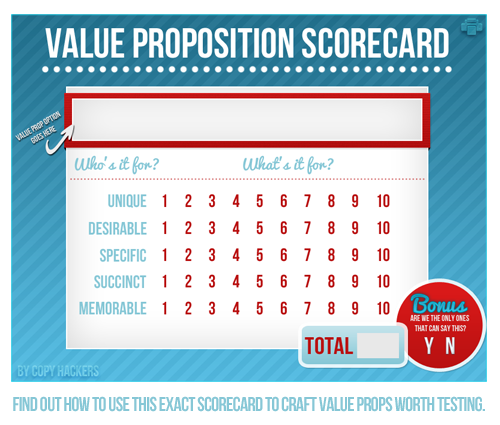
2. Arrangement
Arrangement is the system used for the organization of arguments in Western classical rhetoric. The word is Latin, and can be translated as “organization” or “arrangement.” It concerns the crafting and delivery of speeches and writing.
Once you have the basis of your argument, you have to organize it in the most persuasive way. According to ancient philosophers, there are five elements of arrangement…
- Introduction. Position the argument and yourself and grab the audience’s attention.
- Statement of Fact. State the facts of your argument keeping opinion separate.
- Confirmation of Fact. Present your case (i.e. your desired action) using rhetoric.
- Refutation. Attack opposing arguments by poking holes in their facts and case.
- Conclusion. Summarize what you’ve said and restate your call to action.
Consider Airtable…
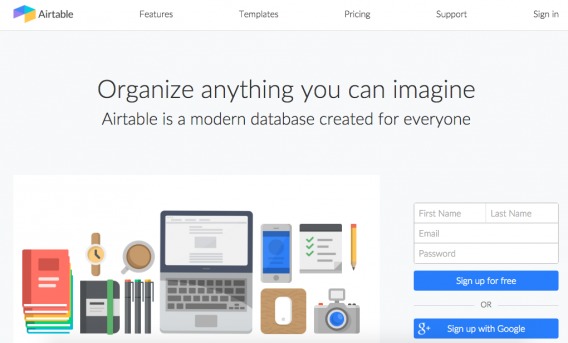
What the heck does “a modern database created for everyone” mean? They’ll organize anything I can imagine? So, my closet? My cupboards? All of these questions and the only call to action above the fold is “Sign up for free”, really?!
Now let’s look at Si digital, which you’ve likely heard of because their site is often celebrated for design / UX…
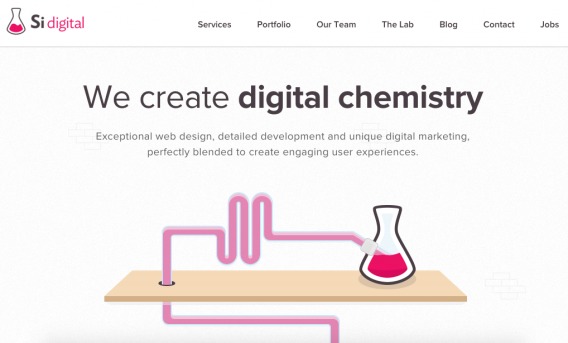
As you scroll down, the pink liquid fills the tube and they take you through their value proposition (e.g. “Not just another agency”, “Always responsive”, “Let’s stay together”). Only when the facts have been represented do they introduce a call to action…
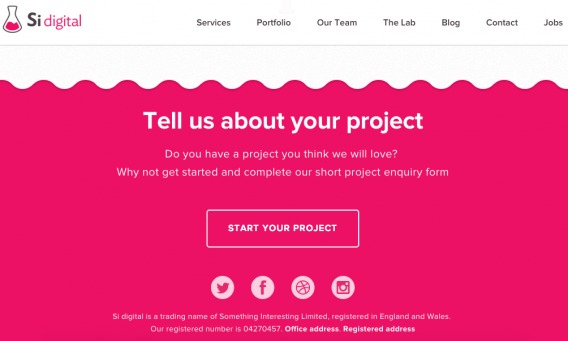
3. Style
Style is the term for the mastery of stylistic elements in Western classical rhetoric and comes from the Latin loqui, “to speak”. It concerns the crafting and delivery of speeches and writing.
Any copywriter knows that the words you choose are as important as the argument you choose. Style is about the aesthetics and pathos.
For example, The Juicery Co. uses straightforward, logical language to explain their juices…
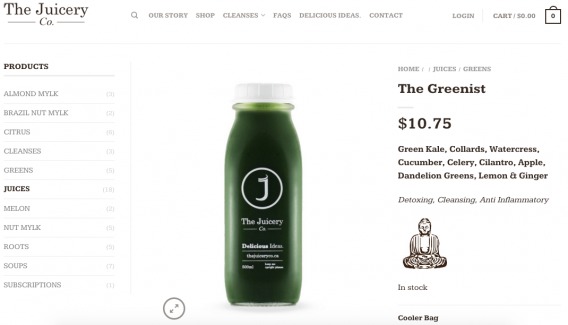
Innocent Drinks, on the other hand, uses language with a bit more style…
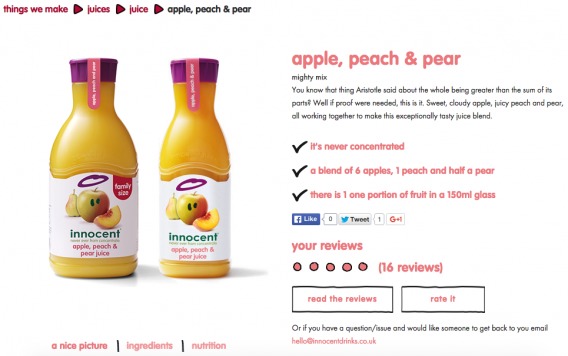
According to Cicero, there are two core elements to style…
- Eloquence. The words flow easily, often using subtle rhyme and alliteration.
- Power. High impact words and phrases triggering strong emotional responses.
Essentially, style is about making the best use of language by writing copy in a way that flows smoothly and evokes powerful emotion.
How to apply it…
- Have personality. There are dozens of companies making healthy, organic green juices. If the product and price are essentially the same, what sets you apart? Personality. Let it show through your copy.
- Instead of writing a lot of copy, use high impact words. Say more with less. Style is about using language to get to your point as quickly as possible (later, you can explain it in more depth).
- Think of this the way you think of onboarding. Your goal is to get the customer to your core value as quickly as possible, but later on, they will discover even more value.
- When you’re done writing, have a teenager or someone who has English as a second language read your copy. Where do they get stuck? What words and phrases are confusing to them? As a writer, it’s easy to overestimate readability.
4. Memory
Memory was the term for aspects involving memory in Western classical rhetoric. The word is Latin, and can be translated as “memory.”
It concerns the crafting and delivery of speeches and prose. It’s the discipline of recalling the arguments of a discourse.
Since these theories and processes were created when public speaking was the popular channel, remembering your speech without a reference point was vital. Today, not so much.
However, memory is still important for two reasons…
- Memory Recall. Draw on your audience’s pre-existing memories to solidify your argument.
- Memory Retention. Make your argument unique and memorable.
Memory Recall
Consider Internet Explorer’s Child of the 90s nostalgia campaign…
Or, more recently, Mazda’s Driving Matters campaign…
Both draw on memories from the past. If you were born in the 90s, you likely have happy memories associated with Pogs, Tamagotchis, Lunchables, etc. If you were born in the 70s (or prior to), Mazda just took you on a trip down memory lane.
Both of these campaigns use nostalgia to get their audience in the right frame of mind, the frame of mind that makes it easier to persuade them.
According to multiple studies from 2013, nostalgia makes people feel closer to the people around them and more optimistic about the future. In one study, participants listened to songs or read song lyrics from the past.
Participants then felt more connected to those around them, which increased self-esteem, which increased optimism for the future.
Drawing on nostalgia creates (a) a connection / trust and (b) optimism / happiness. That’s why memory recall is so powerful.
Memory Retention
Memory retention is another story. What makes your copy memorable?
- Evoking an emotional response. What should your visitors feel after reading?
- Creating contrast. Now vs. later, with vs. without. Contrast helps drive points home.
- Unusual words / concepts. Unexpected words and concepts make visitors stop and think since it’s unfamiliar. (P.S. You can read about the science of familiarity here.)
- Creating shock. Do you have any shocking statistics or statements? If so, use them to create happiness (a positive surprise) or fear (an inconvenient truth).
- Humor. Can you use your copy to tell a joke without sacrificing clarity?
- Repetition. If you want something to be remembered, repeat it in different words.
Consider the humor in this copy…

The contrast in this copy…

Or just think about some of the most popular brands today. What companies do these taglines belong to?
- Save money. Live better.
- The happiest place on earth.
- Finger lickin’ good.
If you guessed Walmart, Disneyland and KFC, you just helped prove the power of memorable copy.
5. Delivery
Delivery was the discipline of delivering speeches in Western classical rhetoric. It concerns the crafting and delivery of speeches.
Rhetoricians laid down guidelines on the use of the voice and gestures (actio) in the delivery of oratory. There were instructions on the proper modulation of the voice (volume and pitch), as well as the phrasing, pace, and emphasis of speech. Also covered were the physical aspects of oration: stance, gestures, posture, and facial expressions.
Like memory, delivery is a little different today than it was in Ancient Greece. Today, the factors of delivery are:
- Medium. A landing page? A PPC ad? A print ad? An email?
- Length. 3,000 words like CXL or 300 words like Seth Godin?
- Format. Small, scannable paragraphs with lots of subheadings? Large, academic-style bodies of text? Typography on an image?
- Font. Speaking of typography, what message is your font sending your audience?
- Images. How do the images surrounding your copy impact your argument?
- Speed / Readability. How quickly does the page load? How easy is it to read and comprehend the copy?

Joanna Wiebe, Copy Hackers & Airstory:
“Do yourself a MASSIVE favor, and start ‘scientific copywriting’. Take a hiatus from being ‘creative’ and look at your website like a lab, not an easel.” (via Copy Hackers)
Michael Aagaard has published a various copywriting case studies over the years. For example…
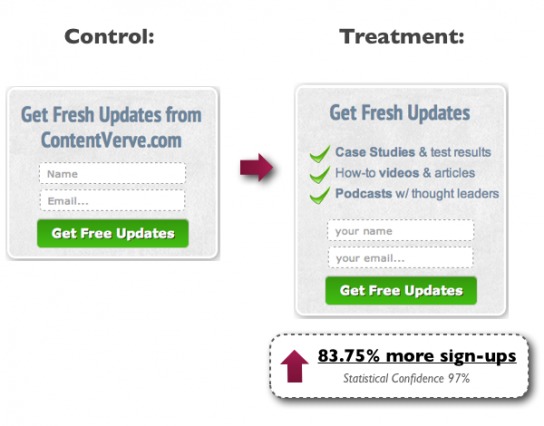
Adding the checkmark images, extending the length of the value proposition and using a list format resulted in a huge lift.
In another case, Michael changed a PPC landing page’s headline from “You work out smarter at Fitness World” to “Group training & fitness at your local gym”. The results…?
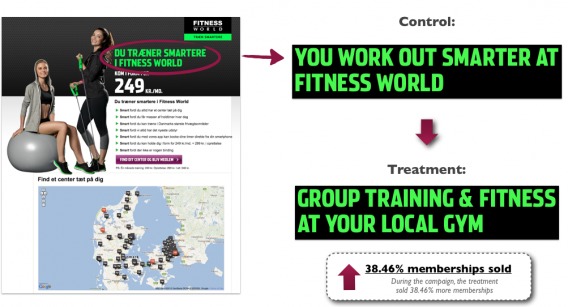
I’d argue this lift was due to the speed / readability improvement. As Michael wrote, “I have yet to see a creative message beat a clear, concrete value proposition in an A/B test.”
Consider the copy-image relationship in this WWF ad…
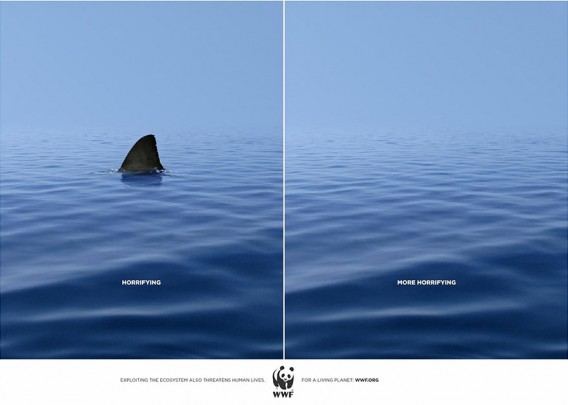
Both the copy and the images are simple, but impactful. Neither one detracts from the other. Instead, they work together to deliver a powerful argument. (Make sure to use Wynter to conduct copywriting research – learn what works or doesn’t in your copy + design combo).
Conclusion
Plato, Aristotle and Cicero don’t know anything about the Internet. They don’t know what CRO stands for.
However, the ancient Greeks really understood the art of persuasion. It was the lifeblood of their society. To not steal their theories and apply them to modern copywriting would be just plain stupid.
The game has changed, but persuasion is still persuasion and the ancients were extraordinary copywriters. [Tweet It!]
First, use ethos, pathos and logos to craft your argument…
- Inject personal stories and successes into your copy to show you have real world experience.
- Use testimonials and other forms of social proof to demonstrate authority.
- Offer a privacy policy, a satisfaction guarantee, free shipping, etc. to build goodwill.
- Borrow credibility from someone with more ethos than you.
- Write the way you would speak if you were delivering your copy orally.
- Use stories and visuals to fully capture your visitors’ problem and the future (feat. your product or service).
- Ask questions to push your visitors to think about their problem and the potential solution.
- Combine ethos, pathos, and logos, but end on pathos. What will trigger such a strong emotional response that your visitors will have no choice but to respond to your call to action?
Then, use the five canons to massage and deliver it…
- Finalize your value proposition (invention).
- Organize your argument in a convincing way (arrangement).
- Add personality and improve readability (style).
- Create nostalgia and an argument that visitors will remember later on (memory).
- Choose your medium, format, font, etc. based on your audience (delivery).




This was a fantastic presentation of the ways to make your copy more effective. I enjoyed how you took from the Ancient Greek philosophers and their method of persuasive public speech and showed us how these ancient thoughts relate to us just as much now as ever before. It’s beautiful to realize we use the same methods to convey ideas as the Ancient Greeks.
Thanks for sharing this. I’m sure I will use this in my personal copy, as well as, incorporating it into the way that I train my tribe.
Thanks so much, Lynan! I’m glad you found it helpful.
It’s really interesting to see how heavily their thoughts and processes influence us, without our knowledge.
Shanelle, thanks for your fantastic post. You put a lot of hard work into that!
FYI, I also wrote one on Aristotle’s Ethos/Pathos/Logos: http://www.credosity.com/blog-speed/get-your-way-aristotle/
You might like the infographics in it, as another take on the topic. I also see them as a process: Heart –> Head –> Cred.
What do you think?
Thanks for the kind words, Paul.
I just read your post and I like the idea of a process, but I find that they work best when used together vs. separately or in a specific order. The only “order”, if you can call it that, that I’ve found to work is a strong pathos appeal near the end.
Anyway, thanks again for the comment and the good read.
Good point, Shanelle. You can’t beat a closing Pathos appeal. People buy/act for emotional reasons.
I see the heart –> head –> cred process most useful when talking to someone, or in short messages like emails. You connect authentically and build ‘liking,’ then you give them your left-brained argument, and then you back it up with some cred!
Awesome. Any sites in particular that are doing this really well via email? I’d love to check them out.